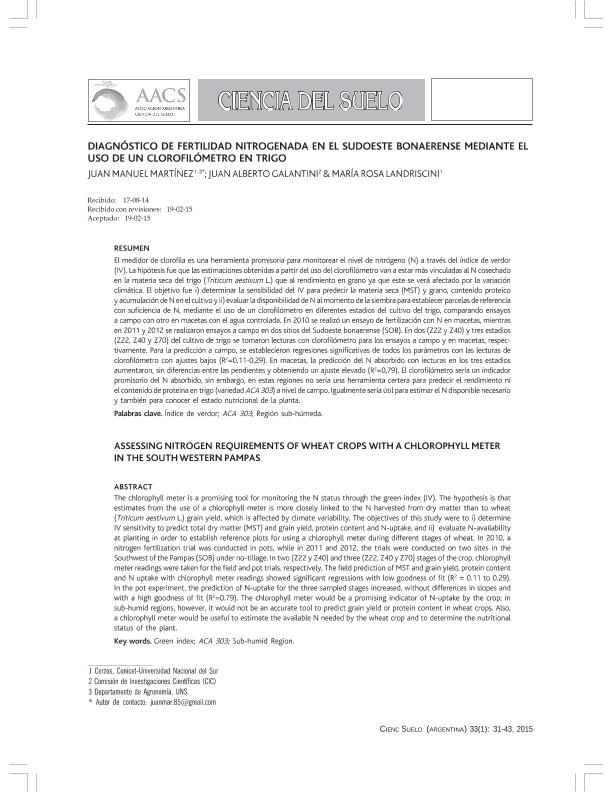Mostrar el registro sencillo del ítem
dc.contributor.author
Martinez, Juan Manuel

dc.contributor.author
Galantini, Juan Alberto
dc.contributor.author
Landriscini, Maria Rosa

dc.date.available
2017-01-16T19:49:58Z
dc.date.issued
2015-07
dc.identifier.citation
Martinez, Juan Manuel; Galantini, Juan Alberto; Landriscini, Maria Rosa; Diagnóstico de fertilidad nitrogenada en el sudoeste bonaerense mediante el uso de un clorofilómetro en trigo; Asociación Argentina de la Ciencia del Suelo; Ciencia del Suelo; 33; 1; 7-2015; 31-43
dc.identifier.issn
0326-3169
dc.identifier.uri
http://hdl.handle.net/11336/11420
dc.description.abstract
El medidor de clorofila es una herramienta promisoria para monitorear el nivel de nitrógeno (N) a través del índice de verdor (IV). La hipótesis fue que las estimaciones obtenidas a partir del uso del clorofilómetro van a estar más vinculadas al N cosechado en la materia seca del trigo (Triticum aestivum L.) que al rendimiento en grano ya que este se verá afectado por la variación climática. El objetivo fue i) determinar la sensibilidad del IV para predecir la materia seca (MST) y grano, contenido proteico y acumulación de N en el cultivo y ii) evaluar la disponibilidad de N al momento de la siembra para establecer parcelas de referencia con suficiencia de N, mediante el uso de un clorofilómetro en diferentes estadios del cultivo del trigo, comparando ensayos a campo con otro en macetas con el agua controlada. En 2010 se realizó un ensayo de fertilización con N en macetas, mientras en 2011 y 2012 se realizaron ensayos a campo en dos sitios del Sudoeste bonaerense (SOB). En dos (Z22 y Z40) y tres estadios (Z22, Z40 y Z70) del cultivo de trigo se tomaron lecturas con clorofilómetro para los ensayos a campo y en macetas, respectivamente. Para la predicción a campo, se establecieron regresiones significativas de todos los parámetros con las lecturas de clorofilómetro con ajustes bajos (R2 =0,11-0,29). En macetas, la predicción del N absorbido con lecturas en los tres estadios aumentaron, sin diferencias entre las pendientes y obteniendo un ajuste elevado (R2 =0,79). El clorofilómetro sería un indicador promisorio del N absorbido, sin embargo, en estas regiones no sería una herramienta certera para predecir el rendimiento ni el contenido de proteína en trigo (variedad ACA 303) a nivel de campo. Igualmente sería útil para estimar el N disponible necesario y también para conocer el estado nutricional de la planta.
dc.description.abstract
The chlorophyll meter is a promising tool for monitoring the N status through the green index (IV). The hypothesis is that estimates from the use of a chlorophyll meter is more closely linked to the N harvested from dry matter than to wheat (Triticum aestivum L.) grain yield, which is affected by climate variability. The objectives of this study were to i) determine IV sensitivity to predict total dry matter (MST) and grain yield, protein content and N-uptake, and ii) evaluate N-availability at planting in order to establish reference plots for using a chlorophyll meter during different stages of wheat. In 2010, a nitrogen fertilization trial was conducted in pots, while in 2011 and 2012, the trials were conducted on two sites in the Southwest of the Pampas (SOB) under no-tillage. In two (Z22 y Z40) and three (Z22, Z40 y Z70) stages of the crop, chlorophyll meter readings were taken for the field and pot trials, respectively. The field prediction of MST and grain yield, protein content and N uptake with chlorophyll meter readings showed significant regressions with low goodness of fit (R2 = 0.11 to 0.29). In the pot experiment, the prediction of N-uptake for the three sampled stages increased, without differences in slopes and with a high goodness of fit (R2 =0.79). The chlorophyll meter would be a promising indicator of N-uptake by the crop; in sub-humid regions, however, it would not be an accurate tool to predict grain yield or protein content in wheat crops. Also, a chlorophyll meter would be useful to estimate the available N needed by the wheat crop and to determine the nutritional status of the plant.
dc.format
application/pdf
dc.language.iso
spa
dc.publisher
Asociación Argentina de la Ciencia del Suelo

dc.rights
info:eu-repo/semantics/openAccess
dc.rights.uri
https://creativecommons.org/licenses/by-nc-sa/2.5/ar/
dc.subject
Indice de Verdor
dc.subject
Aca 303
dc.subject
Región Sub-Húmeda
dc.subject.classification
Agricultura

dc.subject.classification
Agricultura, Silvicultura y Pesca

dc.subject.classification
CIENCIAS AGRÍCOLAS

dc.title
Diagnóstico de fertilidad nitrogenada en el sudoeste bonaerense mediante el uso de un clorofilómetro en trigo
dc.title
Assessing nitrogen requirements of wheat crops with a chlorophyll meter in the south western pampas
dc.type
info:eu-repo/semantics/article
dc.type
info:ar-repo/semantics/artículo
dc.type
info:eu-repo/semantics/publishedVersion
dc.date.updated
2017-01-13T19:22:06Z
dc.identifier.eissn
1850-2067
dc.journal.volume
33
dc.journal.number
1
dc.journal.pagination
31-43
dc.journal.pais
Argentina

dc.journal.ciudad
Buenos Aires
dc.description.fil
Fil: Martinez, Juan Manuel. Consejo Nacional de Investigaciones Científicas y Técnicas. Centro Científico Tecnológico Bahía Blanca. Centro de Recursos Naturales Renovables de la Zona Semiárida(i); Argentina. Universidad Nacional del Sur. Departamento de Agronomía; Argentina
dc.description.fil
Fil: Galantini, Juan Alberto. Provincia de Buenos Aires. Gobernación. Comisión de Investigaciones Científicas; Argentina
dc.description.fil
Fil: Landriscini, Maria Rosa. Consejo Nacional de Investigaciones Científicas y Técnicas. Centro Científico Tecnológico Bahía Blanca. Centro de Recursos Naturales Renovables de la Zona Semiárida(i); Argentina. Universidad Nacional del Sur. Departamento de Agronomía; Argentina
dc.journal.title
Ciencia del Suelo

dc.relation.alternativeid
info:eu-repo/semantics/altIdentifier/url/http://ref.scielo.org/38vhhw
Archivos asociados
